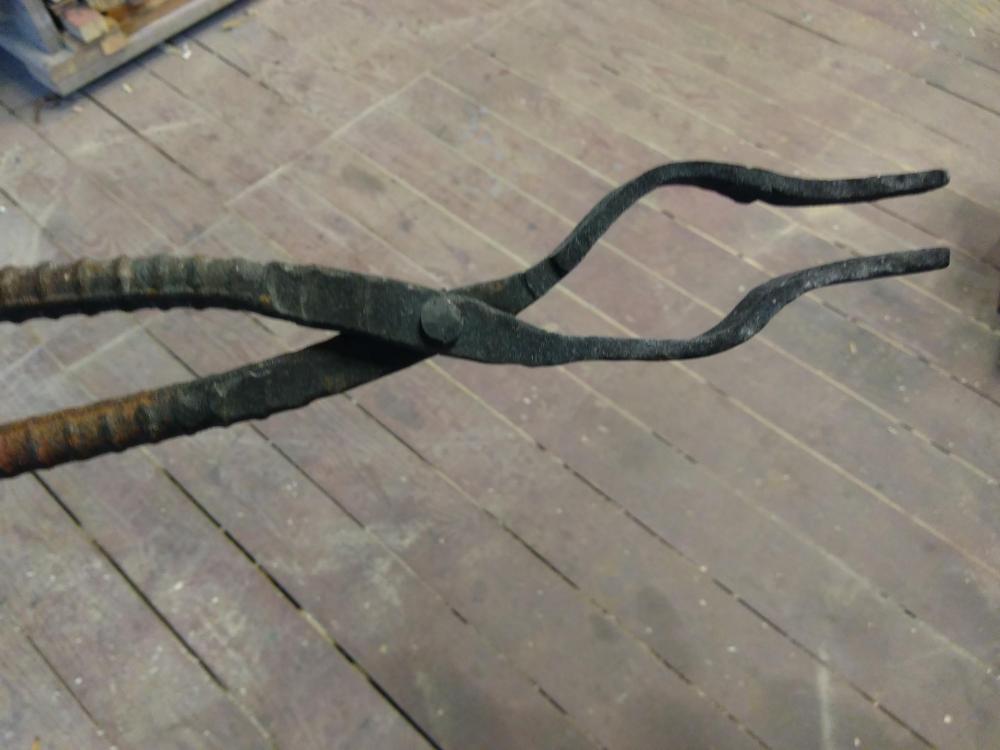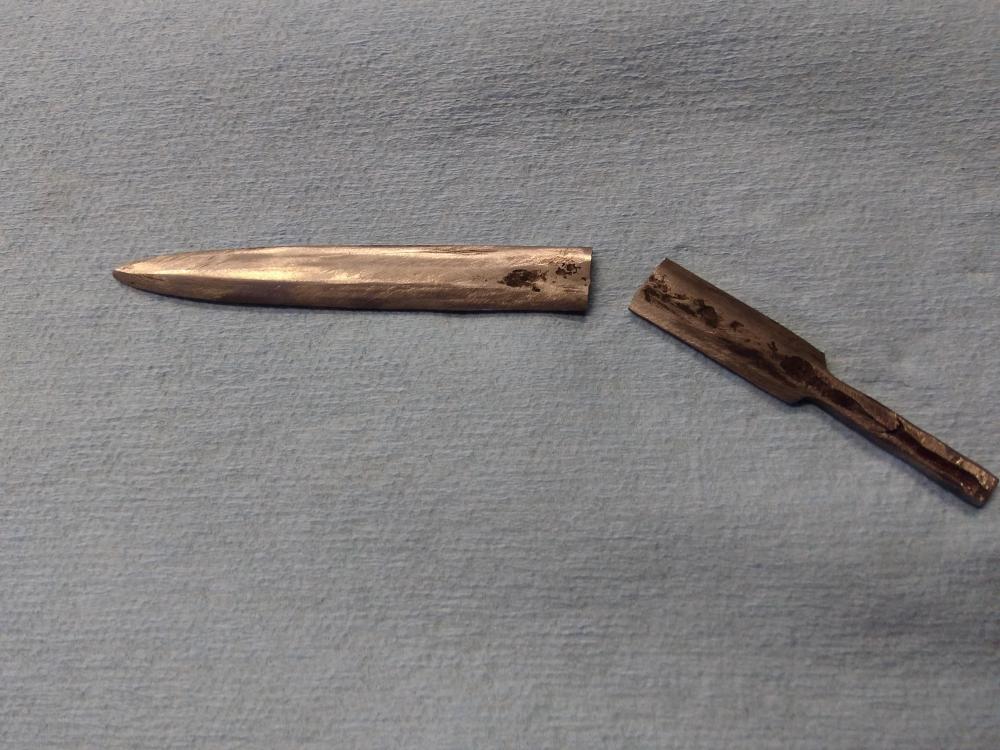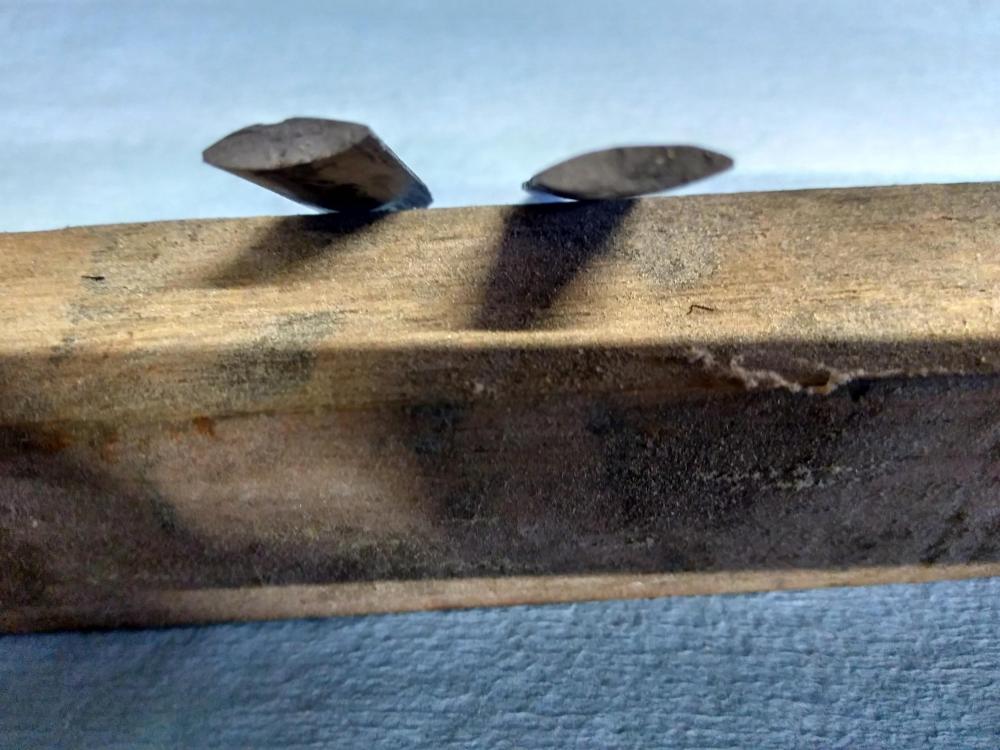
bluerooster
Members-
Posts
567 -
Joined
-
Last visited
Content Type
Profiles
Forums
Articles
Gallery
Downloads
Events
Everything posted by bluerooster
-
Blacksmith Sayings Proverbs
bluerooster replied to Borntoolate's topic in Blacksmithing, General Discussion
I was told by a guy I used to work with: "Don't hammer cold steel, or th' devil will get ya." I can only presume the devil will get you due to the cussin' involved with trying to move cold steel. -
What did you do in the shop today?
bluerooster replied to Mark Ling's topic in Blacksmithing, General Discussion
-
What I did with my old Buck, is just re-shape the blade to a new point. It's only a little shorter.
-
I am a very noob to forging. I've only actually made one useful item, tongs, which I'd not set out to make. I was just heating and hammering on a length of rebar, simply to learn how to swing a hammer, not intending to make anything at all, but just to move hot metal. That rebar turned into ugly but functional tongs. (even a blind dog can find a bone once in a while) Well, next time i fired the forge, I decided to see how a bearing race would behave. It was an outer race for a large ball bearing. I cut it in half, and tossed it in the fire. I set about the task of flattening it out, which, if you can imagine what a ball bearing race looks like, made a nice curve. As I flattened the thick part, It in effect drew it out on that side, and made a nice curve. Many heats, and much hammering, I ended up with a straight (ish) piece of steel about 8" long, and mabe 3/16" thick. I didn't want it to be that long, or that thin, so I folded it in half, and re-heated it, sprinkled som borax on it, and stuck it back in the fire. Durn near burned it, getting it hot, brought it out and gave it a few licks, then re-heat, and a few licks on the other end. disgusted with it, I threw it back in the dying forge, and walked away. I was out of charcoal anyway. After a week or so, I set about seeing what I'd done to it. It was a bit rough around the edges, with de-lamination, but appeared to be stuck together in the middle. So, I heated it up, and drew it out to about 6" long x about an inch wide. Got it to a good red temperature, fully soaked, and dunked it into a bucket of water. I figure that would make it brittle. It sure did! I clamped it in the vise and snapped it off about mid way. Looking at the "end grain" (carpenter here) I could see what had stuck, and what had not. I took one half, and welded a handle on it, By setting up my forge better, better layer of charcoal, less air, and much drawing and folding, I figured out what I was doing, and where I was going wrong. I still have a long way to go. I drew, and folded this chunk, about 10 times, before I ran out of charcoal again. It was a week before I got anymore charcoal, and work, and life in general. I decided one day that I would draw this chunk out, and see what it wants to become. With my old cross peen body hammer, I managed to draw, and shape something that looked kinda like a blade. But not big enough for anything but a filet knife, so I figured on mabe something that favored a miniature sword. I drew it on out, and gave the shape of a double edge blade, with tang. Today, I filed it to better shape, and decided to harden it. Interesting thing, hardening of steel. I had no "quench oil" But I had a half quart of ATF so thats what I used. I clamped the tang in vicegrips with the blade pointing upward at about 40* angle, with vicegrips laying on the table. Played the torch over it from bottom to top untill it turned a cherry red color, and held it there for a bit, to ensure that it was thoroughly soaked, then into the oil. I pulled it from the oil, and hit it with a file, which dug right in. Hmmm, sez I. Mabe I didn't get it hot enough. Oh well, it's just a letter opener, no need to be hard, or sharp, for that matter. I wiped the oil off, and drug it accross a stone to remove the worst of the file marks. Well, I noticed a spot that could use another lick with the file, so I went to file it. Huh. It's hard, the file just skates. Interesting. Well, curiosity got the better of me, I clamped it in the vice, and snapped it off. Woo-Hoo! Hard, and brittle, just what I wanted. Tempering would have come later. Tongs, After the snap, and end grain after the snap.
-
First experience with bloom steel
bluerooster replied to matthewfromers's topic in Smelting, Melting, Foundry, and Casting
That would be Tamahagane . -
Based upon my (not extensive) research, tie rod could be either 4140, or 1144.
-
Thanx for the comments. I'm just a beginner at this, and learning how metal behaves under the hammer. Thanx for the info about light hits at first to "set" the weld. I'll give it a go and see what happens. I'm certian that what I have when I harden it and break it will be areas of fusion, and delamination around the edges. The first time I watched a smith weld, was a wagon wheel tire. It was a scarf joint. He beveled the ends, heated to temp, and told me that it only gets 3 licks, to weld. I don't even think he used any flux. When it was hot, he hit the joint middle, end, end, and that was it. Back to the fire, and level out the joint. He told me that those 3 licks made the weld. The rest was simply to "take out the hump". He never mentioned anything about hard, or light on the hammer blows. I believe it was a 2 1/2 pound cross peen, that he used. It was many years ago. I'll post a pic or two as soon as I can take some. I'm the worlds worst about not taking pictures. I just never think about it, until it's too late.
-
Not really a project per se, but just learning how to heat in a forge to move metal. My first attempt at forging anything, was heating, and beating on a piece of re bar, just to see how to heat and move it. At the end of the day, I had burned up many pounds of charcoal, several inches/feet of material, and wound up with serviceable tongs. Not nice, and well finished by any wild stretch of the imagination, but usable. I then decided to find out how hard steel works. I had a mid shaft bearing out of a 2000 chevy pickup, cut it apart, and threw the outer race into the fire. Using my newly fabricated "tongs", I retrieved the now hot race, and proceeded to try to beat it into submission with my 5 pound hammer. My plan was to flatten it out, then fold it, and weld it. It took many heats, and lots of charcoal, but I finally got it somewhat flat. I couldn't believe that it took so much effort. Disgusted, I tossed it into the dying forge, and put my tools away. I've been massaging steel for nearly 30 years. I can take a flat sheet of steel and turn it into a fender for a model A Ford, with nothing but a couple hammers, files, and dollys. I can take a mangled frame and with controlled heat, and well placed blows, bring it back to shape, shrinking, and stretching as need be. Then it dawned on me. After a week or so of life getting in the way, I fired up the forge, got a better bed of coals, and more on top, better air control, thus generating a nice neutral hot spot. somewhere in the middle. Using a smaller hammer, and warmer metal, I got that bearing race flattened out, and folded. Now what, let's see if I can get the thing to stick together. Hmmm, I read somewhere that I need some flux of some sort. I remember Dad mentioning something about borax, So I raid th' ol' ladys washing soap and found a box of 20 mule team borax. I got that flattened, folded bearing race warm again, and shoved it into the box of borax, much like you would a brazing rod. pulled it from the borax and stuck it back into the forge, cranked up the air, and waited. It got hot, white hot, appeared to me like it was starting to melt, (excessive borax) I snatched it from the fire, and literally beat the daylights out of it. About 6 good licks, until it started to look orange. back into the forge, it opened right up. well dang. I didn't do something right. Or I did something wrong. Got it good and warm again, sprinkled a pinch of borax so that it would melt and run into the split. Back to the forge. Good and hot, gave it 3 quick licks starting at the fold, working back. Back in the forge. By this time, I'd learned that I needed to keep a good layer of charcoal on the bottom, about 2" thick, and then rake more on top of the work to hold the heat. I slowed down the air some, and found that while it took a little longer to heat, it burned less fuel, and material. I went on to draw, and fold several more times. Then I decided to weld a handle to this chunk of mess. I rounded up a scrap of square stock about 18" long, and welded it on one end. Back in the forge. This chunk of whatever it is, is now about 3/8" thick, and about 3" long. I set about seeing how far I could stretch it. I set a goal of 1/8" thick, 5/16 wide, and about 6" long. And so it began, I started out with a 2 pound hammer. I got it to about 1/4" thick and 4 1/2" long, then it developed a crack about mid way. I was about out of fuel in the forge anyway, so I just shoved it into the coals, and put my tools away. Week later, I took that chunk of, ??? out of the cold forge, and clamped it in the vise. Snapped it off at the crack, and examined the end grain. The crack went through the entire thickness, about a third of the way through the width, no sign of delamination. Took both pieces to the grinder, and cleaned them up a little. They looked OK to me, so I clamped them in the vise, and wired them together. All I had on hand was some .040 safety wire, but it seemed to hold them together quite well. set it by the forge and went to the local coke dealer. He's closed until after the new year. So, off to wally world for a bag of charcoal. They were out of Royal Oak, so I picked up a bag of the cheaper stuff, Just as well, I'm short of cash anyway. Got back home, and set about the task of busting up the chunks into usable size. Got a bucket full, and fired up the forge. I wanted to see what would happen with this chunk of ???? wired together. Remember, it started life as a bearing race, it is now ????, as I have no clue what I've done to it. Got the forge started, and tossed it in, added more fuel, and waited for things to get going. Once the forge got going good, I re-arranged the coals, laied the chunk on, and added more fuel to the top. turned on the blower, which by this time I'd added a method of regulating air flow. A slow steady flow of air, instead of the full blast I'd had before. it took a bit longer to heat the work piece, but that is a good thing (I think). Looking through the cracks in the coals, I could see the metal getting red, Once it was an even color of red, I pulled it out, and sprinkled some borax on the joint, it melted immediately, I flipped it at tossed some on the other side, and back to the fire. Looking again through the cracks, it started getting red, then bright red, then finally it blended in with the heat of the forge. I snatched it from the forge, and 3 licks, end, middle, end, and back to the fire. I didn't even bother to look at it, beyond those three licks with a 2 pound hammer. When it got to the same color as the hottest part of the forge, I pulled it out and gave it another three licks, in same order, removed the wire, and back to the heat. I'm amazed, it never got colder than bright orange. At this point, I've no clue if it welded or not. I figure that the next time out would tell the tale. Got it good and red, bright red actually. Pulled it out, and started the draw. Found that the 2 pound hammer was a bit much for that. Was actually tiring holding it back. And a small bit of delamination where the handle was welded on. Mabe the handle was acting as a heat sink, so I put it back in the forge only to heat the delam part. got it to white hot, and smacked it about 6 good licks with my body hammer. back to the heat. bein's how it's a small piece, I used my old cross peen body hammer from here on. Red hot, it moved quite well with very few licks, cooled rapidly. Took many re-heats to get it drawn out, but I got it to about 6"x1/8"x1/4". No sign of delamination, and cooling in the forge now. I'll inspect it in a few days when I have the time.
-
My first attempt at forging anything, was heating, and beating on a piece of re bar, just to see how to heat and move it. At the end of the day, I had burned up many pounds of charcoal, several inches/feet of material, and wound up with serviceable tongs. Not nice, and well finished by any wild stretch of the imagination, but usable.
-
One thing I have learned via cutting various different alloys for 25+ years is this: The softer the material the more disc it will eat. I don't know why, but a bearing race will not eat up a cutting disc as fast as a chunk of re bar. Oh, and thanx for the PDF that was good reading. :D
-
Those tongs look way better than mine. But "form follows function". :D
-
Just beginning. and probably not doing it right. But I'll learn (the hard way) just like I've learned everything else. I built my forge using what I had on hand. My first project was tongs, forged from a piece of re-bar. Those tongs have been a useful tool. I'm currently using charcoal, but I may give coal, or coke a go, and see what the difference is. Store bought hardwood charcoal seems to burn up pretty quickly, but it does make nice heat. Mabe I'm giving it too much wind. Anyway, Thanx for the forum, it comes up every time I do a google search when looking for an answer to a question. Ya'll have been a wealth of info, albeit posts from 10 or more years back that I've been directed to by google. Anyway I figured I'd best join up, lest I miss something. :D I have been in the bodywork business since about 1982, and can pretty much make sheet metal do what I want it to, along with heavier steel such as car frames. But this forging thing is a whole 'nother ball of wax.
.jpg.c404a3e19324e72ca99385fe5a54591f.jpg)
.jpg.80e1a17ce26935f61dbb20a046babdb4.jpg)


